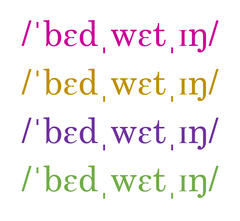"Bedwetting" Defined
In this post we aim to clarify some of the terminology that relates to bedwetting.

“Noctural enuresis”
The medical term for night-time bedwetting is nocturnal enuresis. It refers to involuntary urination during sleep, after the age at which bladder control usually occurs (5+ years). Nocturnal enuresis is one of the most common paediatric health issues [1].
“Monosymptomatic enuresis”
Children that wet the bed and do not have any other lower urinary tract symptoms, or a history of bladder dysfunction, have monosymptomatic enuresis. Monosymptomatic enuresis is usually divided into primary nocturnal enuresis (PNE) and secondary enuresis (SNE) (see below).
“Non-monosymptomatic enuresis”
Non-monosymptomatic enuresis describes children that have other symptoms present alongside nocturnal enuresis. Typically, these symptoms reflect lower urinary tract (LUT) dysfunction, such as LUT pain, urgency for the bathroom, and difficulty in urinating. If your child is suffering from these symptoms, or other similar symptoms, then you should consult a GP for advice.
“Primary nocturnal enuresis” (PNE)
Children that have never been dry at night for a prolonged period of time (6 months or more) have primary nocturnal enuresis. This is the most common form of nocturnal enuresis - it is estimated that around 80% of children with nocturnal enuresis have primary nocturnal enuresis [2].
“Secondary nocturnal enuresis” (SNE)
Children aged 5 or over that have previously achieved 6 months or more of night-time dryness but then start wetting the bed tend to have secondary nocturnal enuresis. Secondary enuresis is commonly triggered by an unusually stressful event in a child’s life, such as the birth of a sibling or parental separation. It should also be checked that the child has not developed a urinary tract infection (UTI) as this could be another cause for the onset of wetting.
Conclusion
Primary monosymptomatic enuresis is very common. The National Institute for Health and Care Excellence (NICE) recommend bedwetting alarms as the first line treatment for primary monosymptomatic enuresis and secondary monosymptomatic enuresis [3]. If your child is showing other symptoms alongside their bedwetting and you suspect that they may have non-monosymptomatic enuresis, then you should visit a GP. 
References
[1] www.urology.ucla.edu
[2] DiBianco, J. M., Morley, C., Al-Omar, O. 2014. Nocturnal enuresis: A topic review and institution experience. Avicenna J Med., 4(4): 77-86.
[3] Nocturnal enuresis: the management of bedwetting in children and young people. NICE clinical guideline 111 (2010).
